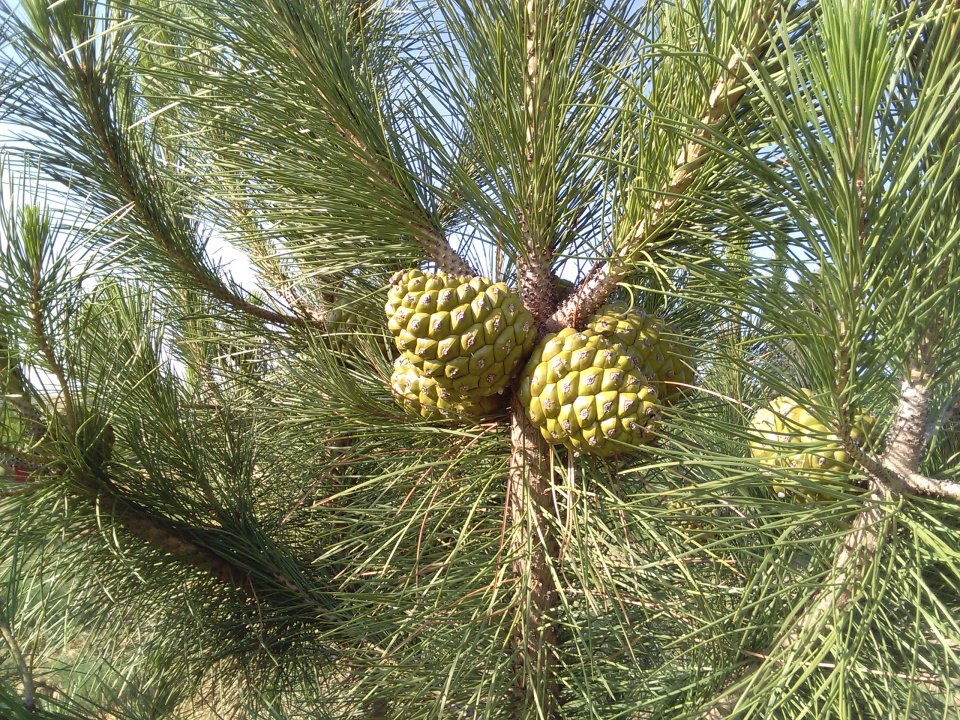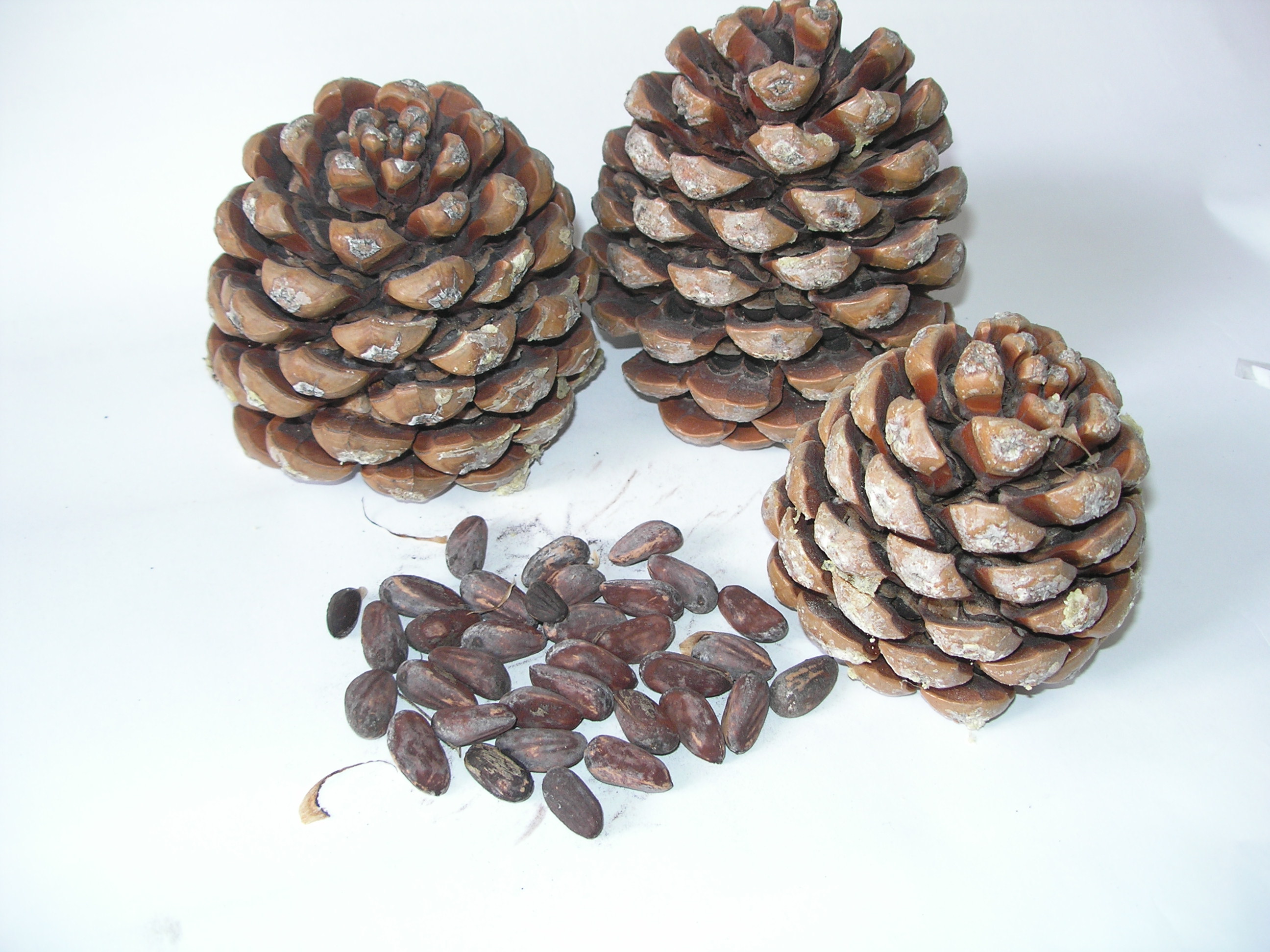
The high prices paid for genuine Mediterranean pine nuts kernels as gourmet nuts are due to an sustained demand on the world market, not met by the production harvested from the wild. The use of grafted Mediterranean stone pine trees allows landowners to establish profitable new plantations with precocious cone yields. For this purpose, genotypes have been selected in Spain and Portugal. Here we present 15 clones registered in Spain with estimated gains of around +10-30% in mean cone yield.
The Mediterranean stone pine, Pinus pinea, is one of the most emblematic Mediterranean trees. Its edible pine nut kernels are esteemed for their fragrant taste and superior nutritive values, and as cultural heritage. Today, they are the most expensive nuts sold in groceries and supermarkets, due in part to the effects of droughts and pests that for years have severly reduced the pine nut supply from the wild. There is an increasing shortfall in the supply of genuine Mediterranean pine nuts to meet the world demand, hence, an interesting business opportunity exists for stone pine growers.
In recent decades, prospection of stone pine trees with outstanding individual cone yields has led to the registering of 15 elite clones in Spain as qualified or tested basic materials for their use in grafted orchards, following evaluation in grafted comparative trials in different regions. Their use in grafted orchards permits a sustained increment in per-hectare cone yields, and optimised tending techniques are under development. In Portugal, a list of 64 plus trees sampled in pine forests was registered in 2009 as qualified clone mixture for supply of graft scions to private land owners, still pending their evaluation in ongoing grafted comparative trials.
The pine clones registered as basic materials for graft scions provide an opportunity to establish orchard plantations with cone production after only a few years , bypassing the juvenile phase without cone formation in non-grafted pine trees. In coastal areas of Portugal or Catalonia, private landowners experienced in growing stone pine are opting for grafting in situ on local rootstocks. However, there is the commercial alternative of container-raised treelets grafted in the nursery, which provides a ready-to-go solution for newcomers or for establishing orchards in less favourable climate conditions like inner Spain where in situ grafting often fails.
When establishing a new plantation, using the maximum available number of different clones is recommended. By labeling the genetic identity of each tree, the pine grower will be able to compare their local performance and production.
Despite the existing demand for grafted trees by private landowners, the forest nursery sector in Spain has only started in 2020 to supply them commercially, once authorised mother plant fields fo scion supply have been established. In Portugal, two approved mother plant fields or 'clonal parks' have been supplying tens of thousands of scions over the last ten years. Vegetative material of pines cannot be exported from Portugal due to quarantaine measures to protect against the fatal Pine Wood Nematode.
Grafted stone pine as novel crop will require a further development of good management and tending techniques, from optimised nursery production of garanted-quaility grafted treelets, plantation, tending, tilling, pruning and fertilisation, up to integrated pest management.
Extended use and further comparison of the available clones, as well as ongoing progeny trials, will define the cultivars best adapted for each agroclimatic region.
Sven MUTKE, mutke@inia.es, http://www.inia.es
Further information
Mutke, S., Guadaño, C., Iglesias, S., León, D., Arribas, S., Gordo, J., Gil, L., Montero, G., 2017. Selection and identification of Spanish elite clones for Mediterranean pine nut as orchard crop. Options Méditerranéennes A 122, 71-75. http://om.ciheam.org/article.php?IDPDF=00007244
Guadaño, C., Mutke, S. (coord.), 2016. Establecimiento de plantaciones clonales de Pinus pinea para la producción de piñón mediterráneo. Monografías INIA: Serie Forestal Nº 28, INIA, Madrid. ISBN: 978-84-7498-565-8. http://libros.inia.es/libros/product_info.php?products_id=737
Iglesias, S., León, D., Guadaño, C., Gordo, J., Mutke, S., 2014. Nuevas perspectivas en los aprovechamientos del pino piñonero. Plantaciones con clones obtenidos en el programa de mejora genética forestal para la producción de piñón. Foresta 62, 18-23. enlace
Mutke, S., 2018. Mediterranean pine nuts – from forests or from plantations ? New management approaches under global change. Scientific Seminar "Roots to riches, genetics and products of stone pine & Mediterranean oaks" EFI/Euforgen/Evoltree, Alghero, Sardegna, September 26, 2018. enlace
Mutke, S., Vendramin, G.G., Fady, B., Bagnoli, F., González-Martínez, S.C., 2019. Molecular and Quantitative Genetics of Stone Pine (Pinus pinea). in: Nandwani D. (ed.), Genetic Diversity in Horticultural Plants, Sustainable Development and Biodiversity 22. Springer International Publishing, Cham: p. 61-84. ISBN: 978-3-319-96453-9 doi:10.1007/978-3-319-96454-6_3
(c) S. Mutke

Mediterranean pine cones and nuts (S. Mutke)
